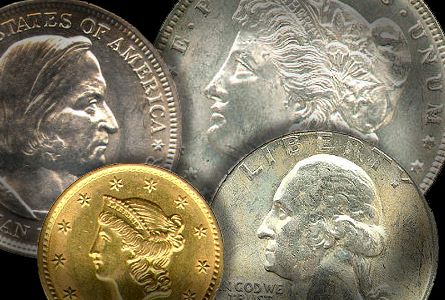By Al Doyle for CoinWeek ….
“Don’t buy common coins” is standard and wise advice. Ironically, many who dispense that bit of numismatic counsel make a good chunk of their income from dealing in everyday material. What sounds contradictory on the surface can be explained logically.
Common Coins Propel the Market, But is Buying them a Good Idea?
No one stays in business by not meeting the needs and wants of customers, and many buyers seek common items such as silver and gold Eagles, moderately price Morgan and Peace dollars and inexpensive coins ranging from pre-1959 Lincoln cents to circulated type. It’s one thing to sing the praises of Draped Bust half dollars or Classic Head $2.50 and $5 gold. Trying to pay the bills within such narrow niches is a completely different matter.
 So why do collectors who have acquired a good measure of knowledge sometimes indulge at the common coin buffet? Why eat beans and cornbread when T-bone steak is also on the numismatic menu?
So why do collectors who have acquired a good measure of knowledge sometimes indulge at the common coin buffet? Why eat beans and cornbread when T-bone steak is also on the numismatic menu?
In real, non-coin life, how many people can indulge in T-bones on a regular basis? Plain old financial reality means most numismatists have to arrange their finances and work within the restrictions of a budget. In the current economic climate, that often means limited discretionary funds.
It sometimes comes down to a choice between a better date and a more common item. If the options are a heavily worn, scruffy key with little eye appeal or a blazing, well-struck common piece for the same money, it’s not hard to see why many collectors would opt for the more abundant date. Looks count for a great deal in daily life and in numismatics.
Even though rarity is an important component of coin collecting, artistic appeal is also high on the list. Hobbyists like to study and examine their purchases, and having items with abundant luster and clean surfaces can mean more than carrying a certain date or mintmark.
An appealing feature of the coin field is the large number of intelligent people who can be found on any bourse floor. Don’t assume that the guy who is buying a circulated common-date Morgan dollar or two-cent piece is someone with limited knowledge. You might have encountered a sharp-minded cherrypicker who just nailed an overlooked VAM or other rare variety. As you can see, some scarcer pieces are disguised as ordinary stuff.
Most Collectors Pursue Coins that they can Afford
If conventional wisdom dictates avoiding more common coinage, what does that mean for the person who can’t afford high-priced keys? If 1921-S Walking Liberty half dollars (or even a nice 1916) aren’t going to be in your future plans, it mean might mean going after the very best and most attractive coins in the moderate price range.
Take proof silver Eagles as an example. This is a modern series for sure, so don’t expect to gain many points in the numismatic sophistication department. Is eye appeal your thing? Mirrored surfaces and frosty cameo devices gives the proof silver Eagles a 10 in appearance. Easy grading and pricing are also positives, and finding buyers once the set is completed won’t be a difficult task.
If older coins are your style, don’t grab the first circulated Liberty nickel or Seated Liberty half dollar that crosses your path. Not all Fines or Extra Fines are equal. Take the time to learn what a “PQ” piece for the grade looks like. Don’t hesitate to spend a little more for the superior coin even if you’re on a tight budget. The cheapest item isn’t always the best value.
Some Common Coins are Actually Quite Uncommon
So how can a common BU 1944 Mercury dime or 1956 Washington quarter be anything more than mundane? Give that piece a splash or two of colorful toning, and you’ve got a winner.
To be honest, some common merchandise is just plain appealing to those who possess the collecting bug. It can be hard to resist a MS-63 or better 1913 type 1 Buffalo nickel in a third-party graded holder. Sneering at a well-struck 1930 Standing Liberty quarter would be a dishonest move for many numismatists. They may be as common as dirt, but the S-mint Morgan dollars of 1879 to 1882 can dazzle the eye with their flashy, well-struck surfaces. If current circumstances means playing the lower end of the price and value scale, strive to find the very best that your limited funds will allow.
Admit it. You don’t have to be a copper buff to appreciate a circulated Coronet large cent or 1857 Flying Eagle cent that has nothing more than honest, even wear on its surfaces. “But those are common dates!” is the cry that rises from the critics and wannabe snobs. Let them shriek and moan. A coin doesn’t have to be worth five figures to be a fine memento and historical keepsake.





Some people can only afford to collect clad coinage they purchase at face value, or from the U.S. Mint, yet they may derive as much pleasure from their pursuit as the doctor who has millions for the finest registry sets. If it makes them happy, that’s all that really matters in the end, esp. since you can’t take it with you.